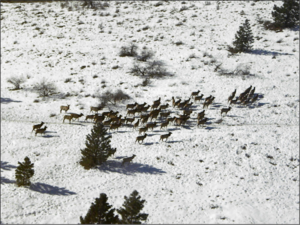
Trail use near Vail, Colorado, has more than doubled since 2009. It’s had a devastating impact on a herd of elk
Biologists used to count over 1,000 head of elk from the air near Vail, Colorado. The majestic brown animals, a symbol of the American west, dotted hundreds of square miles of slopes and valleys.
But when researchers flew the same area in February for an annual elk count, they saw only 53.
“Very few elk, not even many tracks,” their notes read. “Lots of backcountry skiing tracks.”
The surprising culprit isn’t expanding fossil-fuel development, herd mismanagement by state agenciesor predators, wildlife managers say. It’s increasing numbers of outdoor recreationists – everything from hikers, mountain bikers and backcountry skiers to Jeep, all-terrain vehicle and motorcycle riders. Researchers are now starting to understand why.
US national parks and wilderness areas have boomed in popularity in the last decade, with places like Yosemite national park hitting as many as 5 million visits a year. The influx is due to a mixture of visitation campaigns, particularly during traditional “off seasons”, and an explosion of social media exposure that has made hidden gems into national and even international viral sensations.
The impact on wildlife is only recently apparent, and the Vail elk herd may be one of the more egregious examples.
Outdoor recreation has long been popular in Colorado, but trail use near Vail has more than doubled since 2009. Some trails host as many as 170,000 people in a year.
Recreation continues nearly 24 hours a day, 365 days a year, said Bill Andree, who retired as Colorado Parks and Wildlife’s Vail district wildlife manager in 2018. Night trail use in some areas has also gone up 30% in the past decade. People are traveling even deeper into woods and higher up peaks in part because of improved technology, and in part to escape crowds.
The elk in unit 45, as it’s called, live between 7,000 and 11,000 feet on the pine, spruce and aspen-covered hillsides and peaks of the Colorado Rockies, about 100 miles from Denver. Their numbers have been dropping precipitously since the early 2010s.
Blaming hiking, biking and skiing is controversial in a state where outdoor recreation is expected to pump $62.5bn into the state’s economy in 2019, an 81% increase from 2014.
But for Bill Alldredge, a now-retired wildlife professor at Colorado State University, there is no other explanation. He started studying unit 45 in the 1980s in response to expanding ski resorts and trails systems.
To measure the impact on calves, he deliberately sent eight people hiking into calving areas until radio-collared elk showed signs of disturbance, such as standing up or walking away. The consequences were startling. About 30% of the elk calves died when their mothers were disturbed an average of seven times during calving. Models showed that if each cow elk was bothered 10 times during calving, all their calves would die.
When disturbances stopped, the number of calves bounced back.
Why, exactly, elk calves die after human activity as mellow as hiking is not entirely clear. Some likely perish because the mothers, startled by passing humans and their canine companions, run too far away for the calves to catch up, weakening the young and making them more susceptible to starvation or predation from lions or bears. Other times it may be that stress from passing recreationists results in the mother making less milk.
“If you’ve ever had a pregnant wife, and in the third trimester you chase her around the house in two feet of snow, you’ll get an idea of what she thinks about it,” Andree said.
The problems came to a head in 2017, when a group called the Vail Valley Mountain Trails Alliance proposed building a new trail through more of unit 45’s elk calving area.
Andree wrote a letter explaining the dire impact of constant recreation on elk. Even if certain trails were closed during calving season, he said, elk would still be disturbed because some people simply disregarded instructions for them to keep out.
“Generally when you ask people to stay out of the area no matter what the reason is, 80-90% obey you,” Andree said. “But if you get 10% who don’t obey you, you haven’t done any good.”
The recreation community acknowledges its impact on wildlife as well as other development, said Ernest Saeger, the executive director of the mountain trails alliance. Many people don’t understand the significance of the closures. Others, he acknowledged, just don’t care.
So the group formed a trail ambassador program to post more informative signs at closures and even place volunteers at trailheads to explain why trails are closed. The scheme reduced closure violations in 2018, according to Forest Service numbers.
If trail building and closure violations in critical habitat continue, Devin Duval, Colorado Parks and Wildlife’s district wildlife manager in the area, anticipates the worst.
“It will be a biological desert,” he said.
Source: Americans’ love of hiking has driven elk to the brink, scientists say | Environment | The Guardian